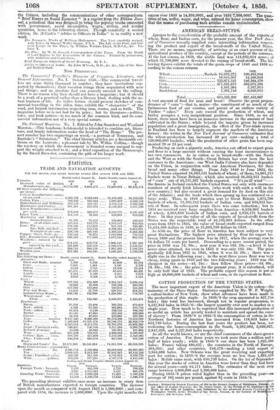AMERICAN IIREAD-STrFFS.
Apropos to the consideration of the probable amount of the &Kiwis of wheat, flour, and Indian corn, for the present year, the New York Jour. nal of Commerce recently supplied some interesting information respect. ing the product and export of the bread-stuffs of the United States. There are no means, apparently, of arriving at an exact account, of the agricultural produce of the country, except at the periods of the censuses. At the last census, in 1850, the arable land was 113,032,614 acres ; of which 51,700,000 were devoted to the raising of bread-stuffs. The fol- lowing figures exhibit the totals of the grain crops of 1840 and 1850 ac- cording to the census returns 1840. 1850.
Wheat Bushels 84,823,272 100,486,944
Rye 18,64.5,567 14,188,813
Oats 123,071,341 146,584,179 Corn 377,631,875 592,071,104 Barley 4,161,504 5,167,615 Buckwheat 7,291,743 , - 8,956,912 Total 615,525,302 867,453,967
A vast amount of food for man and beast! Observe the great prepon- derance of "corn "-that is, maize-the constituent of so much of the farinaceous food of our cousins, and parent of an endless variety of Yankee "cakes." Even oats exceed the production of wheat, and barley occupies a very insignificant position. Since 1850, as we all know, there must have been an immense increase in the amount of land cultivated in the States ; while beyond the impulse given by increased population and a great immigration, the effect of the Free-trade system in England ha a been to largely augment the markets of the American farmer : the writer in the New York Journal of ammerceestimates that the wheat-production has increased 50 per cent-making a total of 150,000,000 bushels ; while the production of other grain has been aug- mented 20 or 25 per cent.
Producing on such a gigantic scale, America can afford to export grain and flour to a large amount without causing the least inconvenience to her own consumers. As in cotton so in bread-stuffs-with the North and the West as with the South-Great Britain has ever been the beat customer to the Americans : our West India Colonies also have depended on the Union, in conjunction with our .American Provinces, for their bread and many other things. From July 1849 to June 1855, the United States exported 18,683,151 bushels of wheat; of these, 14,061,212 bushels went to Great Britain ; which also received 36,563,951 bushels of" corn" out of 43,757,597 bushels exported. "It's an ill wind "- the famine in Ireland enriched the United States not only with enormous numbers of sturdy Irish labourers, (who work with such a will in the new country,) but also created a great demand for its food on this side of the Atlantic ; and the trade which then sprang up has continued on a large scale. Thus, in 1849 America sent to Great Britain 1,072,780 bushels of wheat, 12,396,242 bushels of Indian corn, and 953,815 bar- rels of lour. In subsequent years there was some reduction' but in 1854 we received very large supplies from America-6,058,903 bushels of wheat, 5,965,850 bushels of Indian corn, and 2,026,121 barrels of flour. In that year the value of all the exports of bread-stuffs from the States was the respectable total of 46,195,893 dollars. In the other years from 1849 to 1855, the value of bread-stuffs exported ranged from 11,634,508 dollars in 1850, to 21,003,799 dollars in 1849. As with us, the price of flour in America has been subject to very great fluctuations. The highest price attained by flour for export be- tween 1800 and the present time was in 1817, when the average rose to 14 dollars 75 cents per barrel. Descending to a more recent period, the price in 1836 was 7d. 50c.; next year it was 10d. 25c.-a level it has never since attained, for even in 1855 it was only 10d. 10c. The price gradually fell from 1837 to 1841, when it was 5d. 20e.; there was a slight rise in the following year ; in the next three years flour was very cheap, rising again in 1846 and the two following years ; 1852 was the cheapest in the series-4d. 24c.: then follow these prices-5d. 60c, 7d. 88c., 10d. 10c. ; the price for the present year, it is calculated, will be only half that of 1855. The probable export this season is put as high as 40,000,000 bushelm of wheat and corn, or its equivalent in flour.


































 Previous page
Previous page